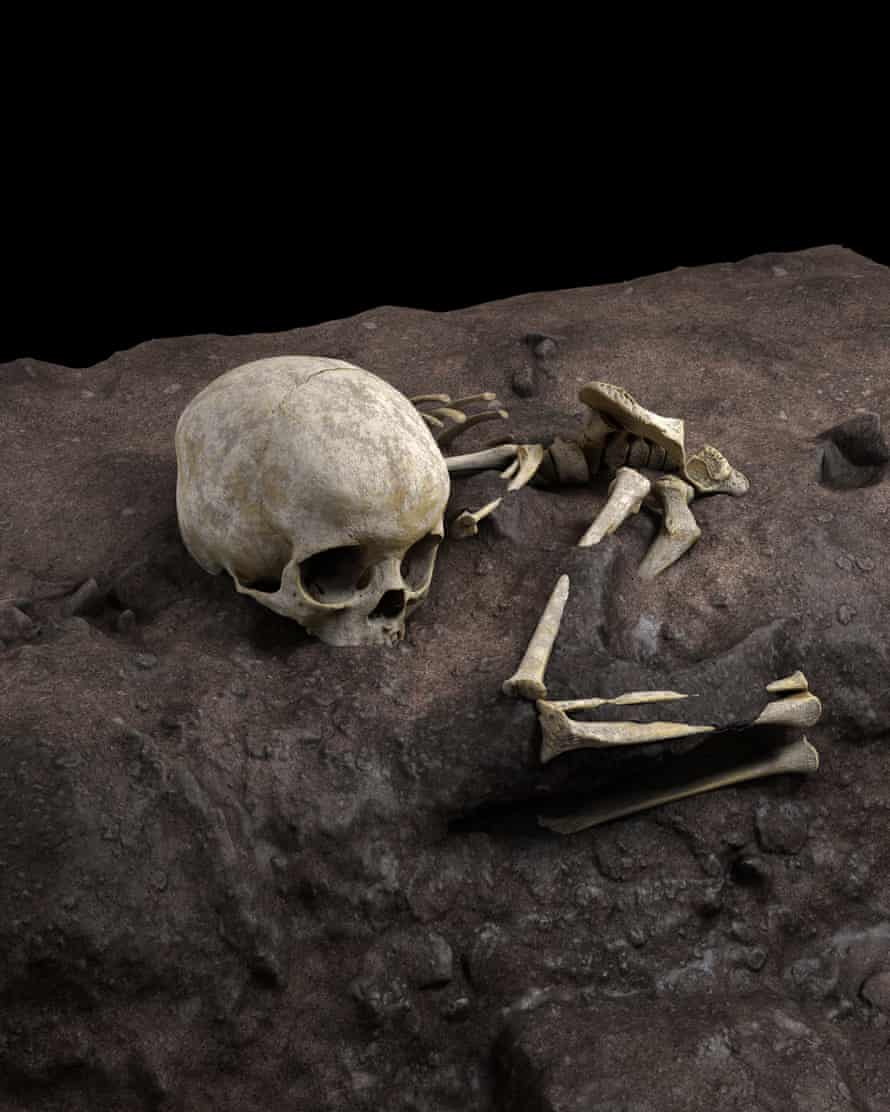Archaeologists have identified the oldest known human burial in Africa during field work that uncovered the remains of a child laid carefully to rest in a grave nearly 80,000 years ago.
The arrangement of the bones shows the three-year-old – named Mtoto after the Swahili word for child – was placed with legs tucked to chest, and perhaps wrapped in a shroud with their head on a pillow, before being gently covered in soil.
Researchers discovered the delicate and degraded bones while excavating the floor beneath a sheltered overhang at the mouth of the Panga ya Saidi cave in the tropical uplands of Kenya’s coastal plain about 10 miles from the shore.
“This is quite spectacular,” said Michael Petraglia, a professor of human evolution and prehistory at the Max Planck Institute for the Science of Human History in Jena, Germany. “It is the oldest human burial in Africa. It tells us something about our cognition, our sociality and our behaviours and they are all very familiar to us today.”

The team unearthed the edge of the grave and the first pieces of bone in 2013, but the fragments were so fragile they turned to dust when the scientists tried to remove them. Over the next four years, the researchers excavated the grave from above, revealing yet more bone, but even after applying resins to the material, it was still too weak to recover.
The researchers decided to dig around the circular pit, roughly 40cm wide and 13cm deep, and encase the whole grave in plaster so it could safely be lifted from the ground. The block was taken to the National Museum in Nairobi and on to a specialist lab in Spain where the material was excavated further and then imaged with 3D X-ray equipment.
Two small teeth found in the grave matched those of Homo sapiens and put the age of the child at two and a half to three years old. Further teeth were still embedded in the child’s lower jaw, discovered with the spine, ribs and other bones from the shoulder and limbs. Stone tools for scraping, boring and engraving were found in and around the grave, alongside stone points that may have been hafted on to wooden shafts to make spears.
The images show that the child was laid on their right side with knees tucked up towards the chest, while the position of the skull suggests that it lay on a headrest or pillow. The articulated bones, such as the spine, had not fallen apart in the grave, leading the researchers to suspect the body was wrapped tightly in a shroud before burial. Dating found the bones to be about 78,000 years old, according to the study published in Nature.
“Humans, unlike chimps, began to develop complex belief systems around death,” said Prof Nicole Bovin, the principal investigator on the project in Jena.
“These are deeply variable cross-culturally, as are ways of treating the dead, so we can’t draw specific conclusions about what the burial signified for people.
“But what seems clear is that there is not just an emotional connection to the dead, but almost certainly also a framework for understanding and navigating death, and for making it meaningful. Unlike other species, we have cosmological belief systems that give meaning to experience and to events like the death of a loved one.”
Archaeologists have found older human burial sites outside Africa. Human remains recovered from burials in the Skhul cave on the slopes of Mount Carmel in Israel and Qafzeh cave near Nazareth are between 90,000 and 130,000 years old.
“Early African burials are especially rare despite the fact that Africa is the birthplace of our species,” said Bovin. “This almost certainly reflects biases in where research has been done – the regions where earlier burials have been found have been much more extensively researched than Africa.
“It’s incredibly rare that we gain access to such a snapshot of a moment in time, especially one so very ancient,” she added. “The burial takes us back to a very sad moment … one that despite the vast time separating us, we can understand as humans.”








